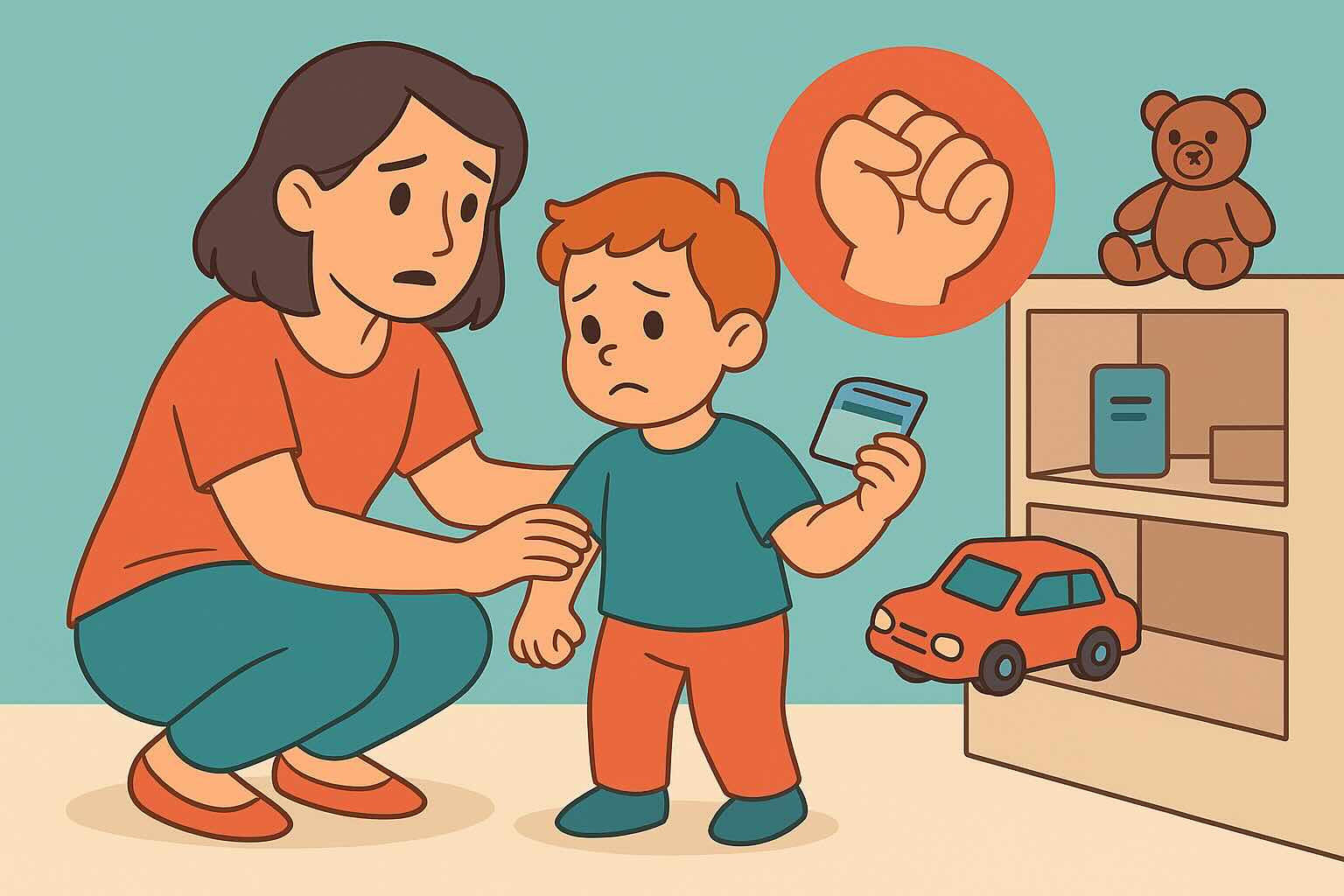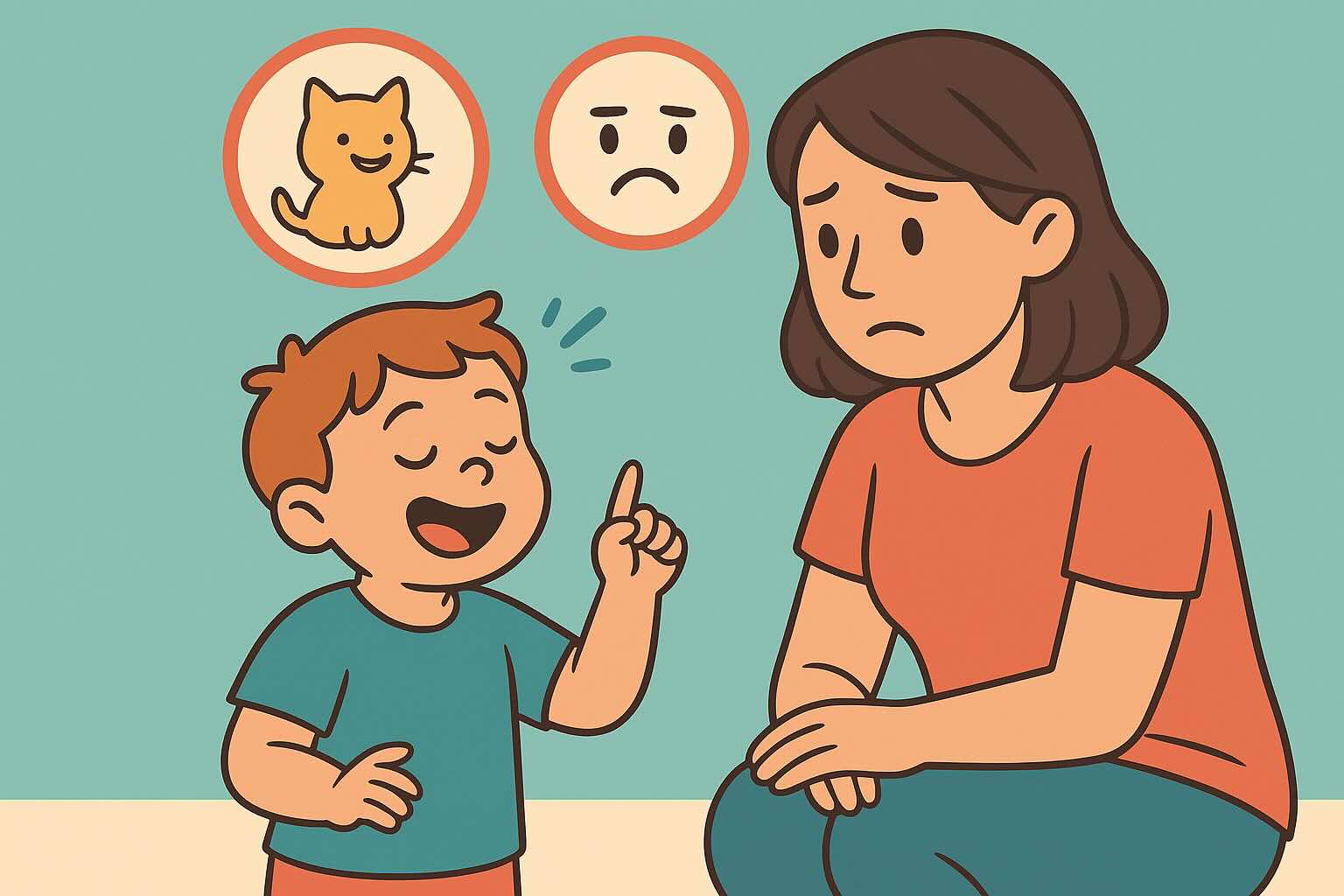When Children Steal: 6 Responses That Teach Respect Without Shame


Discovering that your child has taken something that doesn't belong to them can feel shocking and alarming. You might wonder: "Did I raise a thief? What does this say about their character? How do I make sure this doesn't happen again?" The truth is that taking things without permission is incredibly common in children ages 3-7, and by age 5-6, almost all children will test out this behavior at least once.
This comprehensive guide will help you understand why young children steal, how to respond in ways that teach respect and empathy, and when to be concerned versus when it's simply normal development. You'll learn practical strategies that address the underlying needs driving the behavior while building your child's moral understanding.
For related guidance on honesty and trust-building, check out our complete guide to children's lying behavior and our strategies for building honest communication. Also see our guides on responding to lying and imagination vs deception.
Understanding Why Young Children Take Things
The Developing Brain: Why Self-Control Is Limited
Young children's brains are fundamentally different from adult brains in ways that make stealing more likely:
Limited prefrontal cortex development:
- The brain region responsible for impulse control isn't fully developed until the mid-twenties
- Children literally cannot control immediate desires the way adults can
- The thought "I want it" often translates directly to "I take it" without consideration of consequences
Egocentric thinking:
- Children ages 3-7 naturally see the world from their own perspective
- They don't yet fully understand how their actions affect others
- Their needs and wants feel more important than abstract concepts like "property rights"
Immediate gratification orientation:
- Young children live in the present moment
- Future consequences (getting in trouble, hurting someone's feelings) feel distant and unreal
- The immediate pleasure of having something desired outweighs potential negative outcomes
The 4 Primary Reasons Children Steal
Reason 1: Immediate Desire Without Impulse Control
What it looks like:
- Taking toys from friends' houses
- Pocketing small items from stores
- Taking siblings' belongings without asking
- Grabbing things they see and want
What's happening mentally: "I want this. No one is looking. I'll take it." There's no complex planning or understanding of wrongdoing—just immediate desire meeting limited self-control.
Example scenarios:
- Finding a pretty rock in the teacher's collection and putting it in their pocket
- Seeing candy at a friend's house and taking some home
- Taking a toy from a store display while parents are distracted
Reason 2: Social Pressure and Peer Influence
What it looks like:
- Older children daring or encouraging them to take something
- Trying to impress friends or siblings
- Following along with group behavior
- Wanting to fit in or seem "brave"
What's happening emotionally: The desire for social acceptance and feeling "big" or important can override their understanding of right and wrong, especially when an older or admired child is involved.
Example scenarios:
- An older neighborhood kid dares them to take something from a store
- Siblings encouraging them to sneak cookies or toys
- Friends at school challenging them to take something from the teacher's desk
- Wanting to prove they're "brave enough" to do what bigger kids do
Reason 3: Feelings of Jealousy and Inferiority
What it looks like:
- Taking from children who seem to have "more" or "better" things
- Stealing from siblings during times of comparison
- Taking items that represent what they wish they had
- Targeting specific children they feel jealous of
What's happening emotionally: Around age 5, children begin comparing themselves to others much more intensely. When they perceive others as having more, being better, or getting more attention, stealing can feel like a way to "even the score."
Example scenarios:
- Taking toys from a friend who has many toys when they have few
- Stealing from a sibling who recently got special attention or privileges
- Taking school supplies from classmates who seem to have "everything"
- Pocketing items that represent what they wish their family could afford
Reason 4: Power Struggles and Emotional Expression
What it looks like:
- Taking things from parents when feeling controlled or angry
- Stealing as revenge for perceived unfairness
- Secretive taking that seems designed to upset authority figures
- Escalating taking behavior during times of family stress
What's happening emotionally: Young children have limited ways to express complex emotions like anger, powerlessness, or feeling unheard. Stealing can become a way to reclaim power or express feelings they can't verbalize.
Example scenarios:
- Taking money from a parent's wallet after being denied something they wanted
- Stealing treats after being told "no" repeatedly
- Taking siblings' toys when feeling like parents favor the sibling
- Hiding or taking family items when feeling overlooked or unimportant
The Immediate Response: What to Do When You Discover Stealing
Step 1: Manage Your Own Emotions First
Before confronting your child, take care of your own reaction:
Common parent emotions:
- Shock: "I can't believe my child would do this"
- Shame: "What does this say about my parenting?"
- Anger: "How dare they take something that isn't theirs"
- Fear: "What if this becomes a pattern?"
- Embarrassment: "What will others think of our family?"
Grounding strategies:
- Take 10 deep breaths before saying anything
- Remind yourself: "This is normal developmental behavior"
- Focus on your goal: Teaching, not punishing
- Remember: "My child is learning, not deliberately betraying me"
Step 2: Approach Calmly and Factually
Don't: Ambush them with accusations or interrogate Do: State facts calmly and invite conversation
Effective opening scripts:
- "I found this in your backpack and I know it doesn't belong to you. Do you want to tell me anything about this?"
- "I noticed you have [item] with you. Can you help me understand how you got it?"
- "This looks like something from [friend's house/store/school]. Can we talk about it?"
What to expect: Most children will initially try to deflect responsibility with stories, blame others, or give elaborate explanations. This is normal and expected—don't take it personally or get drawn into arguments about the details.
Step 3: Listen and Validate the Underlying Emotion
Listen to their story completely before responding:
- Don't interrupt or correct them mid-explanation
- Avoid "that's not true" or "stop lying" responses
- Look for clues about their emotional motivation
Validate the feeling behind the behavior:
For immediate desire:
- "I think you really wanted this and when you saw it, you decided to take it. I understand wanting things that look interesting."
For social pressure:
- "It sounds like [older kid] told you to take this. Sometimes when older kids ask us to do things, it feels exciting and important."
For jealousy/inferiority:
- "I think you felt like [friend] has so many nice things and you wanted to have something special too. That's a normal feeling."
For power/anger:
- "I have a feeling you took this because you were mad at me about something. It's okay to be angry sometimes."
Step 4: Set Clear Boundaries About Taking
Explain the concept clearly:
- "When something belongs to someone else and you take it without asking, that's called stealing."
- "Taking things that aren't ours is not okay, even when we really want them."
- "Other people's things are special to them, just like your things are special to you."
Connect to empathy:
- "How would you feel if someone took your favorite toy without asking?"
- "When we take things from others, it can make them sad or worried."
- "Everyone deserves to have their things stay safe with them."
Step 5: Guide Toward Making Amends and Learning
Return the item:
- "We need to return this because it belongs to [person/store]."
- "Let's practice what you can say when we give it back."
- "It takes courage to return something and say you're sorry. I'll help you."
Focus on learning, not punishment:
- "What can you do next time when you really want something that isn't yours?"
- "Let's practice saying 'I really want that, but I can't take it without asking.'"
- "How can you ask for help when you're feeling [jealous/angry/left out]?"
Age-Specific Approaches to Stealing Behavior
Ages 3-4: Foundation Building
At this age, children are just beginning to understand concepts of "mine" vs. "yours."
What's normal:
- Taking toys without understanding they belong to others
- Difficulty with sharing and turn-taking
- Limited understanding of abstract concepts like "property"
- Immediate impulse-driven behavior
How to respond:
- Focus on teaching basic concepts: "This is yours, this is mine, this belongs to Sarah"
- Use simple, concrete language: "We ask before we take"
- Practice asking permission: "Can I please use your crayon?"
- Make returning items a normal part of play: "Let's give this back to Alex now"
Prevention strategies:
- Practice sharing and asking during playdates
- Use books about sharing and respecting others' things
- Create clear physical boundaries: "This is your toy box, this is your sister's"
- Teach the magic words: "May I please...?"
Ages 4-5: Rule Learning
Children this age can understand rules but still struggle with impulse control.
What's normal:
- Testing boundaries around taking things
- Beginning to understand that stealing makes others sad
- Can follow rules when reminded but may forget in the moment
- Starting to feel some guilt about taking things
How to respond:
- Acknowledge their growing understanding: "I think you know that taking things without asking isn't okay"
- Help them recognize feelings: "I think your tummy felt a little funny when you took that toy because you knew it wasn't yours"
- Practice problem-solving: "What could you do next time when you really want something?"
- Introduce simple moral reasoning: "When we take things, it hurts people's feelings"
Prevention strategies:
- Role-play asking to borrow things and gracefully accepting "no"
- Practice waiting and managing disappointment
- Teach coping phrases: "I want it and I can't have it, and that's okay"
- Create opportunities for legitimate ownership and pride
Ages 5-7: Moral Development
Children this age can understand more complex moral concepts but still need guidance with impulse control.
What's normal:
- Understanding that stealing is wrong but still struggling with impulses
- Feeling genuine guilt or shame after taking things
- More elaborate explanations or lies when caught
- May steal due to social pressure or emotional needs
How to respond:
- Address the underlying emotional need: "I think you took this because you were feeling left out"
- Involve them in problem-solving: "What do you think we should do to make this right?"
- Connect to their developing empathy: "How do you think your friend felt when they couldn't find their special pencil?"
- Focus on character development: "What kind of person do you want to be?"
Prevention strategies:
- Have regular conversations about empathy and respect
- Discuss peer pressure and how to handle it
- Teach emotional regulation skills for jealousy and anger
- Create family values discussions about honesty and respect
Addressing Different Types of Stealing Situations
When They Steal from Friends
The situation: You find a toy from a playdate in your child's backpack.
Immediate response: "I see you have Emma's toy. I think you really liked playing with it and wished you could keep it. It belongs to Emma, so we need to return it. Let's practice what you can say when we give it back."
Follow-up conversation:
- "What made that toy so special that you wanted to keep it?"
- "How do you think Emma felt when she couldn't find her toy?"
- "What can you do next time when you really like something at a friend's house?"
Prevention for future playdates:
- Before leaving: "Let's make sure we only take home things that belong to us"
- Teach asking: "If you really like something, you can ask if you can borrow it"
- Practice saying goodbye to special toys: "Bye-bye toy, maybe I can play with you again next time"
When They Steal from Stores
The situation: You discover they've taken something small from a store.
Immediate response: "I found this in your pocket and I know we didn't pay for it. I think you really wanted it and when no one was looking, you took it. We need to return it to the store because it belongs to them."
Return trip to the store:
- Keep it simple: "I took something without paying and I want to return it"
- Stay supportive: Stand near them but let them handle the interaction
- Focus on the learning: "That took courage to return it and say you were sorry"
Follow-up prevention:
- Practice store behavior: "In stores, we look with our eyes and ask with our words"
- Teach the concept of paying: "When we want something from a store, we ask the cashier to help us buy it"
- Give them a small amount of their own money for future store visits
When They Steal from Siblings
The situation: You find they've taken something from their brother or sister.
Immediate response: "I see you have your sister's special bracelet. I think you thought it was really pretty and wanted to wear it. It belongs to your sister, so we need to give it back to her."
Sibling resolution:
- Facilitate the return: "Can you tell your sister what happened?"
- Address the underlying feeling: "It sounds like you wish you had a pretty bracelet too"
- Problem-solve together: "How can you ask your sister if you can borrow things sometimes?"
Prevention strategies:
- Create clear ownership: Label belongings or create separate spaces
- Practice asking siblings for permission to borrow
- Teach graceful acceptance of "no": "It's okay if your brother doesn't want to share right now"
- Address underlying jealousy or competition between siblings
When They Steal Money
The situation: You find money in their possession that you know they didn't earn.
Immediate response: "I found this money and I know it doesn't belong to you. Money is especially important because people work hard to earn it. Can you tell me where you got it?"
Serious conversation:
- Explain the value of money: "People work to earn money to buy things their families need"
- Connect to security: "When money goes missing, it can make people worry about paying for important things"
- Return the money together and apologize if taken from family
- If taken from outside the family, involve the other parents
Long-term prevention:
- Give them opportunities to earn small amounts of money through age-appropriate chores
- Teach about money, saving, and earning
- Create a savings system where they can work toward things they want
- Be clear about family money rules and boundaries
Building Long-Term Respect for Others' Property
Teaching Empathy and Perspective-Taking
Daily practices:
- "How would you feel if..." questions during calm moments
- Point out others' emotions in real-time: "Look, Sarah looks sad that she can't find her toy"
- Share stories about times when your things were taken and how it felt
- Read books about sharing, respect, and empathy
Role-playing exercises:
- Practice asking to borrow things and accepting both "yes" and "no" answers
- Act out scenarios where someone takes their things without asking
- Practice returning things and apologizing
- Explore different solutions to wanting something you can't have
Creating Family Values Around Respect
Family discussions:
- "In our family, we respect other people's things"
- "We ask before we take, and we accept the answer we get"
- "Everyone deserves to feel safe that their things will stay where they put them"
- "When we make mistakes, we make them right"
Practical applications:
- Model asking permission yourself: "Can I borrow your pen?"
- Show respect for their property: Always ask before using their things
- Create family rules about borrowing and returning
- Celebrate when they ask permission or respect others' boundaries
Addressing Underlying Emotional Needs
For children who steal due to jealousy:
- Have regular conversations about fairness and comparison
- Focus on their unique strengths and qualities
- Create opportunities for them to feel special and valued
- Teach coping strategies for jealous feelings
For children who steal due to social pressure:
- Discuss peer pressure and practice saying "no" to inappropriate requests
- Build their confidence in their own decision-making
- Role-play difficult social situations
- Strengthen their sense of right and wrong independent of others' opinions
For children who steal due to anger or powerlessness:
- Create appropriate outlets for big emotions
- Give them legitimate choices and control in their daily life
- Address family dynamics that may be contributing to power struggles
- Teach healthy ways to express anger and frustration
When to Seek Professional Support
Normal Developmental Stealing vs. Concerning Patterns
Normal patterns:
- Occasional taking between ages 3-7
- Shows guilt or remorse when caught
- Responds positively to gentle correction and teaching
- Decreases with consistent, patient responses
- Related to specific developmental challenges (impulse control, understanding rules)
Concerning patterns that may need professional help:
- Frequent, persistent stealing that doesn't improve with consistent intervention
- Stealing that becomes more elaborate or secretive over time
- No apparent guilt, remorse, or concern about the impact on others
- Stealing combined with other behavioral concerns (aggression, lying without remorse, cruelty)
- Stealing that begins or increases dramatically after a major life change or trauma
Environmental Factors to Consider
Assess for underlying stressors:
- Major family changes (divorce, move, new baby, job loss)
- School or social difficulties (bullying, academic struggles, friendship problems)
- Exposure to trauma or family violence
- Inconsistent rules or consequences across different environments
- Peer groups that normalize inappropriate behavior
When to consult professionals:
- If stealing persists or escalates despite consistent, appropriate responses for 2-3 months
- If you suspect underlying emotional trauma or significant stressors
- If family relationships are significantly strained by the behavior
- If stealing is accompanied by other concerning behaviors
- If you feel overwhelmed and need support developing appropriate responses
Types of Professional Support
Child psychologists can assess for underlying emotional needs and provide therapy Family therapists can help improve family communication and dynamics School counselors can address peer pressure and social skill development Pediatricians can rule out developmental or medical factors
Your Action Plan for Addressing Stealing Behavior
Week 1: Assess and Respond
- When stealing occurs, practice the 5-step response framework
- Focus on staying calm and understanding underlying emotions
- Begin having conversations about empathy and respect
- Assess patterns: When does stealing happen? What seems to trigger it?
Week 2: Teach and Practice
- Have family discussions about property, respect, and asking permission
- Practice asking to borrow things and accepting "no" gracefully
- Read books together about sharing and respecting others
- Create clear family rules about taking and borrowing
Week 3: Address Underlying Needs
- Identify which type of stealing your child tends toward (impulse, social pressure, jealousy, anger)
- Have deeper conversations about the emotions involved
- Create opportunities to meet underlying needs appropriately
- Strengthen areas where your child might feel vulnerable or lacking
Week 4: Build Long-Term Skills
- Continue reinforcing respect for others' property in daily life
- Celebrate improvement and growth, even small steps
- Maintain consistent responses to any stealing incidents
- Plan for ongoing character development and empathy building
Key Takeaways: Understanding and Responding to Stealing
- ✅ Stealing is common and normal in children ages 3-7 due to limited impulse control and developing moral understanding
- ✅ Four main reasons: immediate desire, social pressure, jealousy/inferiority, and power struggles/anger
- ✅ Stay calm and avoid shame-based responses that damage your relationship
- ✅ Use the 5-step framework: manage your emotions, approach factually, validate feelings, set boundaries, guide toward amends
- ✅ Focus on teaching empathy, respect, and problem-solving rather than punishment
- ✅ Address underlying emotional needs that drive the stealing behavior
- ✅ Build family values around respect for others' property and belongings
- ✅ Create opportunities for legitimate ownership, earning, and pride
- ✅ Seek professional help if stealing becomes persistent, elaborate, or concerning
- ✅ Remember that character development takes time—be patient with the learning process
Remember: Your child is not "bad" for stealing—they're learning important lessons about respect, empathy, and self-control. Your patient, understanding responses will help them develop into trustworthy, caring people.
This article provides general guidance based on child development principles. Every child and situation is unique. If stealing behavior persists or is accompanied by other concerning behaviors, consider consulting with a child development professional for personalized guidance.
24/7 AI Parenting Assistant
Get instant, personalized advice with expert-curated parenting knowledge. Chat with your AI coach anytime, anywhere.

Trust Building Toolkit
Daily practices and scripts to build unshakeable trust and honest communication with your child.
Frequently Asked Questions
Need personalized support?
RootWise's AI coach can provide tailored strategies for your specific situation, available 24/7 when you need it most.
Learn More About AI Coaching →



